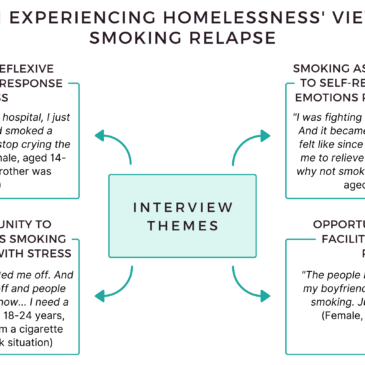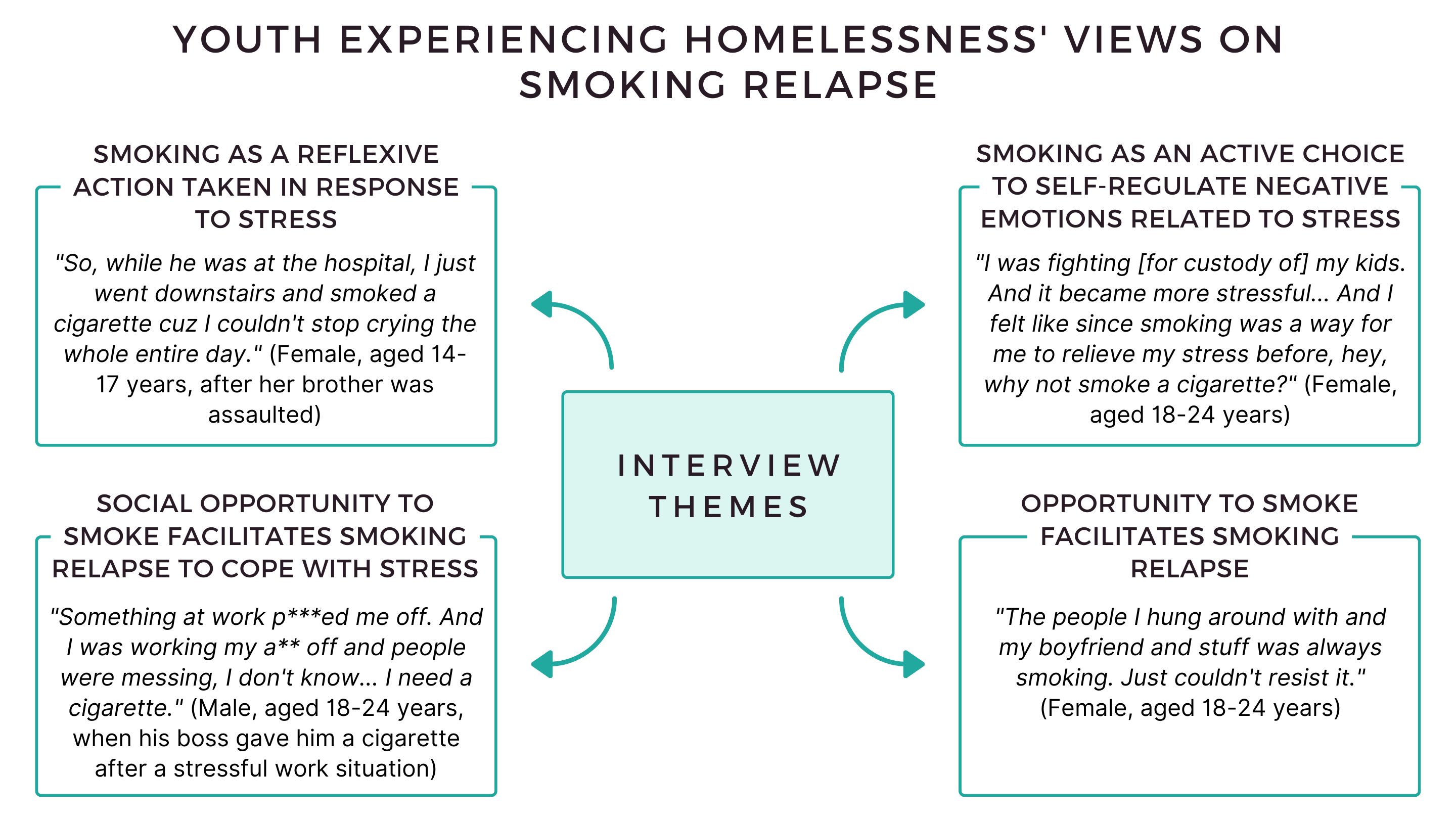Tobacco use is a concern among youth experiencing homelessness; up to 70% of young people experiencing homelessness report smoking cigarettes and many use multiple types of tobacco products. Many youth experiencing homelessness are motivated to quit smoking and have engaged in previous quit attempts, demonstrating that smoking cessation is of interest to this population. Smoking cessation programs should address factors that contribute to smoking relapse. This week, ASHES reviews a study by Joanne G. Patterson and colleagues that examined how stress and opportunities to smoke contribute to smoking relapse in youth experiencing homelessness.
What was the research question?
How do stress and opportunities to smoke contribute to smoking relapse in youth experiencing homelessness?
What did the researchers do?
The researchers interviewed 26 14-24 year olds experiencing homelessness who were attending a drop-in center in a city in Ohio. Participants were current combustible tobacco smokers (e.g., cigarettes, cigars) who reported a past quit attempt. The authors asked participants to describe their experiences with smoking relapse, including what they thought caused their relapse. The researchers analyzed the interviews for common themes pertaining to reasons for relapse (stress, opportunity to smoke, other), types of stressors and smoking opportunities, and self-regulation.
What did they find?
The majority of participants (88.5%) identified stress or the opportunity to smoke as the reason for relapse. Among these individuals, most reported stress (65.2%) or the intersection of stress and the opportunity to smoke (21.7%) as the primary reason for relapse. Thirty-nine percent of participants reported experiencing a major life event, such as death of a friend or family member or an accidental overdose, prior to smoking relapse. Most participants (69.2%) were willing to quit smoking in the next 30 days.
Many participants described smoking as a reflexive action done impulsively to reduce overwhelming negative emotions stemming from experiences of trauma or stress (see Figure). In these cases, they described smoking as a lapse in emotional self-regulation. In other cases, they described smoking as an active choice made to self-regulate negative emotions, improve mood, and manage anger related to stress. Some participants explained that smoking relapse was intentional to reduce stress and avoid more harmful behaviors, including violence. For some participants, social networks that provided the opportunity to smoke facilitated smoking relapse as a means for coping with emotions during a period of stress. For others, opportunities to smoke (e.g., social access to cigarettes or tobacco products), regardless of experiences of stress, facilitated smoking relapse.
Figure. Key interview themes from interviews with youth experiencing homelessness about their views on smoking relapse. Click image to enlarge.
Why do these findings matter?
This study found that stress is a primary reason for relapse among youth experiencing homelessness. Smoking cessation interventions tailored for this population should focus on supporting these youth during periods of heightened vulnerability when they are faced with multiple stressors that could put them at risk for relapse. Interventions might also help youth experiencing homelessness access basic needs, including food and shelter, that, when unmet, can be a major form of stress. In addition, smoking cessation interventions might teach stress-reduction strategies and coping tools that youth can apply as an alternative to smoking.
Every study has limitations. What are the limitations of this study?
Participants were youth experiencing homelessness in a mid-western U.S. city. Findings may not be generalizable to youth experiencing homelessness in other geographic areas. This study did not ask participants about mental health and other substance use, which are associated with smoking cessation attempts.
For more information:
SmokeFreeTeen offers tools and resources for teenagers about quitting and maintaining abstinence from tobacco use. The Centers for Disease Control and Prevention also provides research and tips about cigarettes and how to quit. For additional self-help tools, please visit the BASIS Addiction Resources page.
— Kira Landauer, MPH
What do you think? Please use the comment link below to provide feedback on this article.





